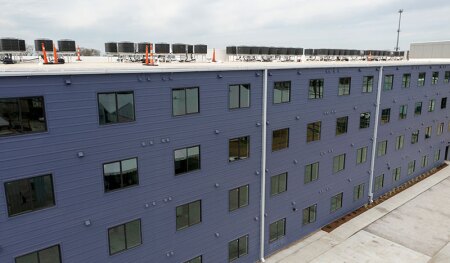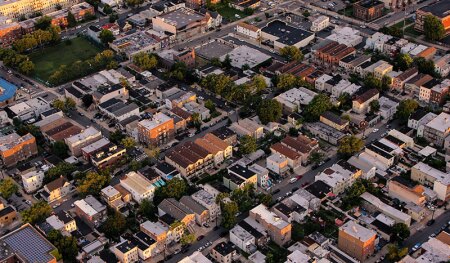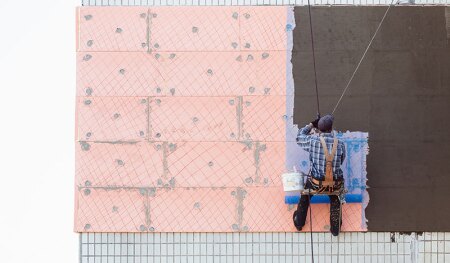
Bottle Art Lofts in Lafayette, Louisiana, is built to the FORTIFIED Gold standard and is better able to withstand severe weather. GRRP can be used to help multifamily properties meet the FORTIFIED standard (a resilient construction method based on decades of research by the Insurance Institute for Business & Home Safety), or other methods of building hardening.
Owners of HUD-assisted multifamily buildings are now eligible for up to $20 million for solar panels, floodproofing, and other similar upgrades.
The Green and Resilient Retrofit Program (GRRP), a new program from the U.S. Department of Housing and Urban Development (HUD), has made $2 billion in funds available from the Inflation Reduction Act (IRA) to support private owners of HUD-assisted multifamily buildings to make decarbonization and resilience upgrades.
The IRA has already gained prominence for the large sums of public and private investment it will stimulate, and this program is no different. Depending on the extent of the project, awards range from $750,000 to $20 million per project, all going toward reducing utility consumption and carbon emissions, improving resident safety and comfort, and preparing buildings for the impacts of intensifying hazards like floods, fires, and extreme heat, for example by using the FORTIFED Multifamily program of the Insurance Institute for Business & Home Safety. (For more on retrofitting for climate hazards, check out ULI’s recent report Resilient Retrofits: Climate Upgrades for Existing Buildings).
Reducing carbon emissions and building resilience to climate impacts are both major priorities for the real estate industry, but owners of multifamily properties serving the lowest-income residents (such as those assisted by Section 8 and other HUD programs) often face unique barriers to incorporating renewable energy, energy efficiency, and resilience features into their buildings.
Filling funding gaps
“Getting upfront capital is sometimes difficult in the multifamily assisted space,” explains Elena Rein, recapitalization program specialist at HUD. The lower rents these properties offer residents are a much-needed boon for affordable housing, but can also mean slim capital budgets for upgrades perceived as expensive.
Generous GRRP award amounts aim to fill that funding gap and help demonstrate the business case for owners. “A lot of these retrofits are incredibly cost effective, and reduce energy and water costs, and they can make the post-hazard event repair process much less costly, not to mention the significant safety and quality of life improvements. There may also be opportunities for insurance costs reductions from some of these enhancements,” Rein notes. (For more on how resilience strategies can add value, visit ULI’s interactive library of resilient project profiles Developing Urban Resilience)
Simplifying application processes
Another challenge: federal funding often carries a reputation for being lengthy, difficult and confusing to apply for. HUD is taking a new approach, according to Rein: “We’ve been thinking about application access as an equity issue. All our properties serve low-income residents, but some owners have more resources than others. We didn’t want a scenario where the program was effectively only available to some.”
GRRP takes two steps to lower that wall. Firstly, owners have three options, or cohorts, for funding: Elements, Leading Edge, and Comprehensive, providing up to $750K, $10M, or $20M per project respectively, and each is designed for projects in different stages of planning and development. “These were designed to meet property owners where they are in terms of property needs. By offering a diversity of program pathways, we think it will make it easier for owners to see themselves in the program and find a way in,” says Rein.
Second, GRRP takes a drastically simplified approach to applications. “Applications are Excel-based and very simple, anything we can calculate for applicants automatically, we do; we use clear color coding and flags for anything incorrect, we provide checklists, and tried to keep applications as short as possible,” Rein notes.
To ensure applicants feel supported through the process, HUD is also offering a range of resources from pre-recorded 10-minute webinars, accessibly written 2-pagers, video walkthroughs of how to fill out each application, live office hours, and an active email to answer questions. It seems applicants appreciate the extra communication: “We answer dozens of questions each week,” says Rein.
Linking decarbonization with resilience
Historically, the number of funding and financing options for building energy efficiency and renewable energy have dwarfed those for floodproofing, hurricane protection upgrades, or other resilience measures.
That has begun to change with the evolution of programs like Property Assessed Clean Energy (PACE), whose newer iterations often cover hazard risk reduction upgrades as well as energy upgrades. GRRP’s predecessor, the Green Retrofit Program, saw success awarding funds for energy retrofits but lacked the critical resilience element that helps protect residents and properties. The inclusion of funds for resilience in GRRP is thus a major step and simplifies planning for owners who might make a round of energy upgrades, only to realize they need to retrofit again for floods or storms.
Rein explains: “When thinking about deep retrofits, whether energy retrofits or any other kind, resilience can be baked in and often more cost-effectively if you’re already retrofitting. If you’re putting solar panels on a property, it doesn’t make sense to put them on a roof that needs to be replaced soon; it also doesn’t make sense to put them on a roof that can’t withstand hurricane winds. The climate resilience infusion makes sense in terms of simple asset management good practice, but also for protecting the investments HUD, owners, and other IRA programs are making.”
The decarbonization and resilience goals are also mutually beneficial in other ways. “These retrofits can make a huge difference in day-to-day comfort for indoor temperatures and air quality, and in case of disaster, protecting tenants—not only from the initial impacts but renewables and battery storage create the ability to operate during a power outage afterward. This is a huge safety concern we’ve seen in the past few years, and unfortunately, a lot of life is lost in the power outage aftermath of disasters,” says Rein.
As climate hazards intensify, programs like GRRP can help plug critical gaps for owners and residents who will benefit from decarbonization and resilience the most, while demonstrating the possibilities and business case for the wider real estate industry.
Interested applicants can learn more at https://www.hud.gov/GRRP.







